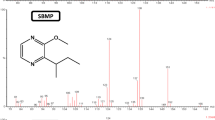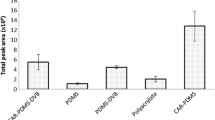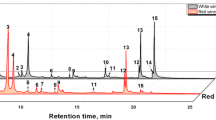Abstract
The system based on coupling a headspace sampler to a mass spectrometer (HS–MS), which is considered one kind of electronic nose, is an emergent technique for ensuring and controlling quality in industry. It involves injecting the headspace of the sample into the ionization chamber of the mass spectrometer where the analytes are fragmented. The result is a complex mass spectrum for each sample analyzed. When several samples are analyzed the data matrix generated is processed with chemometric techniques to compare and classify the substances from their volatile composition, in other words, to compare and classify their flavor. So far, information from electronic nose applications has mainly been qualitative. In this paper we present a quantitative study that uses a multivariate calibration. We analyzed several white wines using HS–MS to determine 2,4,6-tricholoranisole (TCA). This is an off-flavor that is a serious problem for the wine industry. The method is simple because it does not require sample preparation, only addition of sodium chloride being necessary for sample conditioning. Also, it provides a fast screening (10 min/sample) of the quantity of TCA in wines at ultratrace (sub μg L−1) levels.




Similar content being viewed by others
References
Gardner JW, Bartlett PN (1994) Sens Actuators B 18/19:211–220
Newman AR (1991) Anal Chem 63:585–588
Strike DJ, Meijerink MGH, Koudelka-Hep M (1999) Fresenius J Anal Chem 364:499–505
Zubritsky E (2000) Anal Chem 72:421A–426A
García C, Fernández ME, Pérez JL, Moreno B (2001) Quím Anal 20:3–11
Dittmann B, Nitz S, Horner G (1998) Adv Food Sci 20:115–121
Di Natale C, Davide F, D'Amico A, Sberveglieri G, Nelli P, Faglia G, Perego C (1995) Sens Actuators B 24/25:801–804
Di Natale C, Davide F, D'Amico A, Nelli P, Groppelli S, Sberveglieri G (1996) Sens Actuators B 33:83–88
Guadarrama A, Fernández JA, Íñiguez M, Souto J, de Saja JA (2000) Anal Chim Acta 411:193–200
Heberle I, Liebminger A, Weimar U, Göpel W (2000) Sens Actuators B 68:53–57
Guadarrama A, Fernández JA, Íñiguez M, Souto J, de Saja JA (2001) Sens Actuators B 3894:1–8
Cassey JA (1999) Aust NZ Wine Ind J 14:49–56
Silva C, Figueiredo J, San Romao MV (2000) Crit Rev Microb 26:147–162
Buser HR, Zanier C, Tanner H (1982) J Agric Food Chem 30:359–362
Fischer C, Fischer U (1997) J Agric Food Chem 45:1995–1997
Evans TJ, Butzke CE, Ebeler SE (1997) J Chromatogr A 786:293–298
Michel G (1996) Rev Oenol 82:24–26
Riu M, Mestres M, Busto O, Guasch J (2002) J Chromatogr A 977:1–8
Aung LH, Smilanick PV, Vail PV, Preston LH, Gómez E (1996) J Agric Food Chem 44:3294–3296
Pollnitz AP, Pardon KH, Liacopoulos D, Skouroumounis GK, Sefton MA (1996) Aust J Grape Wine Res 2:184–190
Hoffmann A, Sponholz WR, David F, Sandra P (2000) AppNote 3/2000. Gerstel, Mülheim an der Ruhr
Rocha S, Delgadillo I, Ferrer Correira AJ, Barros A, Wells P (1998) J Agric Food Chem 46:145–151
Massart DL, Vandeginste BGM, Buydens LMC, de Jong S, Lewi P J, Smeyers-Verbeke J (1997) (eds) Handbook of Chemometrics and Qualimetrics: Part A. Elsevier, Amsterdam
Osten DW (1988) J Chemom 2:39–48
Mandel J, Linning FJ (1957) Anal Chem 29:743–749
Currie LA (1995) Pure Appl Chem 67:1699–1723
Faber NM (2000) Chemom Intell Lab Syst 52:123–134
Acknowledgments
The authors wish to thank the Ministerio de Ciencia y Tecnología (project ALI97-0765) for providing Mrs Martí's doctoral fellowship, the Universitat Rovira i Virgili for providing Mr Riu's doctoral fellowship and the Ministerio de Ciencia y Tecnología/INIA (project VIN00-045) for their financial support.
Author information
Authors and Affiliations
Corresponding author
Rights and permissions
About this article
Cite this article
Martí, M.P., Boqué, R., Riu, M. et al. Fast screening method for determining 2,4,6-trichloroanisole in wines using a headspace–mass spectrometry (HS–MS) system and multivariate calibration. Anal Bioanal Chem 376, 497–501 (2003). https://doi.org/10.1007/s00216-003-1940-z
Received:
Revised:
Accepted:
Published:
Issue Date:
DOI: https://doi.org/10.1007/s00216-003-1940-z




